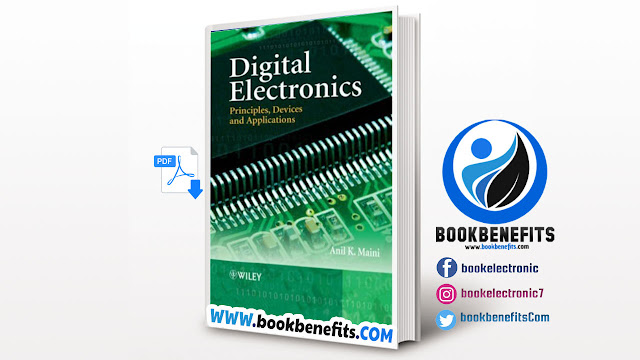Digital Electronics Principles, Devices, and Applications PDF Free Download
Digital Electronics Principles, Devices, and Applications
Picture of the Book:
About Of The Book:
The book covers several new topics, which are of relevance to anyone having an interest in digital electronics and not covered in the books already in print on the subject.
These include digital troubleshooting, digital instrumentation, programmable logic devices, microprocessors, and microcontrollers.
While the book covers in entirety what is required by undergraduate and graduate-level students of engineering in electrical, electronics, computer science, and information technology disciplines, it is intended to be a very useful reference book for professionals, R&D scientists, and students at the postgraduate level.
The book is divided into sixteen chapters covering seven major topics. These are digital electronics fundamentals (chapters 1 to 6), combinational logic circuits (chapters 7 and 8), programmable logic devices (chapter 9), sequential logic circuits (chapters 10 and 11), data conversion devices and circuits (chapter 12), microprocessors, microcontrollers and microcomputers (chapters 13 to 15) and digital troubleshooting and instrumentation (chapter 16).
The contents of each of the sixteen chapters are briefly described in the following paragraphs. The first six chapters deal with the fundamental topics of digital electronics.
These include different number systems that can be used to represent data and binary codes used for representing numeric and alphanumeric data.
Conversion from one number system to another and similarly conversion from one code to another is discussed at length in these chapters.
Binary arithmetic, covering different methods of performing arithmetic operations on binary numbers is discussed next.
Chapters four and five cover logic gates and logic families. The main topics covered in these two chapters are various logic gates and related devices, different logic families used to hardware implement digital integrated circuits, the interface between digital ICs belonging to different logic families, and application information such as guidelines for using logic devices of different families.
Boolean algebra and its various postulates and theorems and minimization techniques, providing exhaustive coverage of both Karnaugh mapping and Quine-McCluskey techniques, are discussed in chapter six.
Digital Electronics: Principles, Devices and Applications is a comprehensive book covering, in
one volume, both the fundamentals of digital electronics and the applications of digital devices and
integrated circuits. It is different from similar books on the subject in more than one way. Each chapter
in the book, whether it is related to operational fundamentals or applications, is amply illustrated
with diagrams and design examples. In addition, the book covers several new topics, which are of
relevance to any one having an interest in digital electronics and not covered in the books already in
print on the subject. These include digital troubleshooting, digital instrumentation, programmable logic
devices, microprocessors and microcontrollers. While the book covers in entirety what is required by
undergraduate and graduate level students of engineering in electrical, electronics, computer science and
information technology disciplines, it is intended to be a very useful reference book for professionals,
R&D scientists and students at post graduate level.
The book is divided into sixteen chapters covering seven major topics. These are: digital electronics
fundamentals (chapters 1 to 6), combinational logic circuits (chapters 7 and 8), programmable logic
devices (chapter 9), sequential logic circuits (chapters 10 and 11), data conversion devices and circuits
(chapter 12), microprocessors, microcontrollers and microcomputers (chapters 13 to 15) and digital
troubleshooting and instrumentation (chapter 16). The contents of each of the sixteen chapters are
briefly described in the following paragraphs.
The first six chapters deal with the fundamental topics of digital electronics. These include different
number systems that can be used to represent data and binary codes used for representing numeric and
alphanumeric data. Conversion from one number system to another and similarly conversion from one
code to another is discussed at length in these chapters. Binary arithmetic, covering different methods
of performing arithmetic operations on binary numbers is discussed next. Chapters four and five cover
logic gates and logic families. The main topics covered in these two chapters are various logic gates
and related devices, different logic families used to hardware implement digital integrated circuits, the
interface between digital ICs belonging to different logic families and application information.
Contents Of The Book :
1. Number Systems
2. Binary Codes
3. Digital Arithmetic
4. Logic Gates and Related Devices
5. Logic Families
6. Boolean Algebra and Simplification Techniques
7. Arithmetic Circuits
8. Multiplexers and Demultiplexers
9. Programmable Logic Devices
10. Flip-Flops and Related Devices
11. Counters and Registers
12. Data Conversion Circuits – D/A and A/D Converters
13. Microprocessors
14. Microcontrollers
15. Computer Fundamentals
16. Troubleshooting Digital Circuits and Test Equipment
2. Binary Codes
3. Digital Arithmetic
4. Logic Gates and Related Devices
5. Logic Families
6. Boolean Algebra and Simplification Techniques
7. Arithmetic Circuits
8. Multiplexers and Demultiplexers
9. Programmable Logic Devices
10. Flip-Flops and Related Devices
11. Counters and Registers
12. Data Conversion Circuits – D/A and A/D Converters
13. Microprocessors
14. Microcontrollers
15. Computer Fundamentals
16. Troubleshooting Digital Circuits and Test Equipment
Information Of The Book:
Name of the book: Digital Electronics Principles, Devices, and Applications PDF

